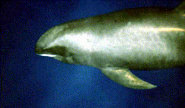 The Melon-headed whale (Peponocephala electra), though commonly called a whate is of a dolphin species that is part of the group known as blackfish. The Melon-headed whale lives in tropical waters, but isn’t seen very often because of its strong preference for deep water.
The Melon-headed whale (Peponocephala electra), though commonly called a whate is of a dolphin species that is part of the group known as blackfish. The Melon-headed whale lives in tropical waters, but isn’t seen very often because of its strong preference for deep water.Appearance and size
Adult Melon-headed whales normally weigh over 450 pounds (200 kg) and usually measure in the neighborhood of 10 feet (3 m) long, a size considerably larger than their approximate 20-30 pound (10-15 kg), 3 foot (1 m) size at birth. As with humans, the females live longer (about thirty years) than the males (about 20 years).
The Melon-headed whale has a rounded, triangular shaped head when viewed from on top or on the bottom. From the sides, the head looks rounded. They often are mistaken as a pygmy killer whale, especially when seen from far away. Their dorsal fin they have is distinctive and is located on their mid-back. Their ventral side is white and The rest of their body varies from black to dark grey. They have an unusual triangle shaped black mask on their face as well as distinctive white lips.
Habitat
Melon-headed whales have been spotted occasionally in odd places around the world, but are primarily found in tropical ocean areas. They can often be seen from the Philippines and from Hawaii.
Food
The diet of the Melon-headed whale is mostly small fish and squid.
Behavior
Melon-headed whales are known to stay in groups of sizes ranging from 100 to 500. Also, they have been known to hang out with other species such as Fraser, Spinner, and Spotted dolphins and short finned pilot whales.
This species regularly participates in mass stranding that result in death. One study documented that beached females outnumbered beached males by 2-1.
Threats
While this species is not officially listed as endangered, pollution, noise pollution, and direct and incidental catching are its primary threats. The only known predators of this species are humans, besides that it is top predator.
The Melon-headed whale is listed as Least Concern (LR/lc), lowest risk. Does not qualify for a more at risk category. Widespread and abundant taxa are included in this category, on the IUCN Red List of Threatened Species
Namings for the melonheaded whale
A young / baby of a melonheaded whale is called a 'calf'. The females are called 'cow' and males 'bull'. A melonheaded whale group is called a 'gam, pod or herd'.Countries
Australia, Brazil, Costa Rica, French Polynesia, Guam, Guatemala, Guinea, India, Indonesia, Japan, Malaysia, Maldives, Mexico, Pakistan, Papua New Guinea, Philippines, Saint Vincent and the Grenadines, Senegal, Seychelles, South Africa, Sri Lanka, United States and VietnamSome facts about the
Melon-headed whale
Adult weight : 206 kg (453.2 lbs)
Maximum longevity : 47 years
Female maturity :4290 days
Male maturity : 2465 days
Gestation : 365 days
Litter size : 1

Custom Search